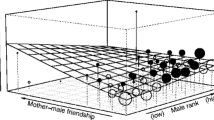Abstract
Family composition is an important predictor of variation in proximity among captive bonnet macaque (Macaca radiata) mothers and their infants. Infants that have several immature sisters in the group are initially more independent that infants with fewer sisters, but as they reach 6 months of age infants with several sisters become less independent than their peers. The effects of the presence of juvenile females on the relative independence of their infant siblings seem to be related to the fact that the members of families with several immature females are the targets of more aggression than are the members of other families.
Similar content being viewed by others
References
Altmann, J. (1980).Baboon Mothers and Infants. Harvard, Cambridge.
Berman, C. M. (1983). Matriline differences and infant development. In Hinde R. A. (ed.),Primate Social Relationships: An Integrated Approach, Blackwell Scientific, Oxford, pp. 132–134.
Berman, C. M. (1984). Variation in mother-infant relationships: Traditional and nontraditional factors. In Small, M. F. (ed.),Female Primates: Studies by Women Primatologists, Alan R. Liss, New York, pp. 17–36.
Chepko-Sade, B. D., and Sade, D. S. (1979). Patterns of group splitting within matrilineal kinship groups.Behav. Ecol. Sociobiol. 5:67–86.
Fairbanks, L. A. (1988a). Mother-infant behavior in vervet monkeys: Response to failure of last pregnancy.Behav. Ecol. Sociobiol. 23:157–165.
Fairbanks, L. A. (1988b). Vervet monkey grandmothers: Effects on mother-infant relationships.Behavior 104:176–188.
Hinde, R. A. (1983). Dyads embedded in a group. In Hinde, R. A. (ed.),Primate Social Relationships: An Integrated Approach, Blackwell Scientific, Oxford, pp. 128–130.
Hooley, J. A. (1983). Primiparous and multiparous mothers and their infants. In Hinde, R. A. (ed.),Primate Social relationships: An Integrated Approach, Blackwell Scientific, Oxford, pp. 142–145.
Hooley, J. A., and Simpson, M. J. A. (1981). A comparison of primiparous and multiparous mother-infant dyads inMacaca mulatta.Primates 22:379–392.
Hooley, J. A., and Simpson, M. J. A. (1983). Influence of siblings on the infant's relationship with the mother and others. In Hinde, R. A. (ed.),Primate Social Relationships: An Integrated Approach, Blackwell Scientific, Oxford, pp. 139–142.
Johnson, R. L. (1986). Mother-infant contact and maternal maintenance activities among free-ranging rhesus monkeys.Primates 27:191–204.
Lancaster, J. B. (1972). Play-mothering: The relations between juvenile females and young infants among free ranging vervet monkeys (Cercopithecus aethiops).Folia Primatol. 15:161–182.
Lee, P. C. (1983). Caretaking of infants and mother-infant relationships. in Hinde, R. A. (ed.),Primate Social Relationships: An Integrated Approach, Blackwell Scientific, Oxford, pp. 145–151.
Lee, P. C. (1984). Early infant development and maternal care in free-ranging vervet monkeys.Primates 25:36–47.
Norusis, M. (1986).SPSS/PC+for the IBM PC/XT/AT, SPSS, Chicago.
Rosenblum, L. A., and Sunderland, G. (1982). Feeding ecology and mother-infant relations. In Hoffman, L. W., Gandelman, R., and Shiffman, H. R. (eds.),Parenting: Its Causes and Consequences, Erlbaum, Hillsdale, NJ, pp. 75–110.
Silk, J. B. (1980). Kidnapping and female competition among captive bonnet macaques.Primates 21:100–110.
Silk, J. B. (1988). Social mechanisms of population regulation in a captive group of bonnet macaques (Macaca radiata).Am. J. Primatol. 14:111–124.
Silk, J. B. (1990). Sources of variation in interbirth intervals among captive bonnet macaques (Macaca radiata).Am. J. Phys. Anthropol. 82:213–230.
Silk, J. B., Clark-Wheatley, C. B. Rodman, P. S., and Samuels, A. (1981). Differential reproductive success and faculative adjustment of sex ratios among captive female bonnet macaques (Macaca radiata).Anim. Behav. 29:1106–1120.
Author information
Authors and Affiliations
Rights and permissions
About this article
Cite this article
Silk, J.B. Mother-infant relationships in bonnet macaques: Sources of variation in proximity. International Journal of Primatology 12, 21–38 (1991). https://doi.org/10.1007/BF02547556
Received:
Revised:
Issue Date:
DOI: https://doi.org/10.1007/BF02547556




